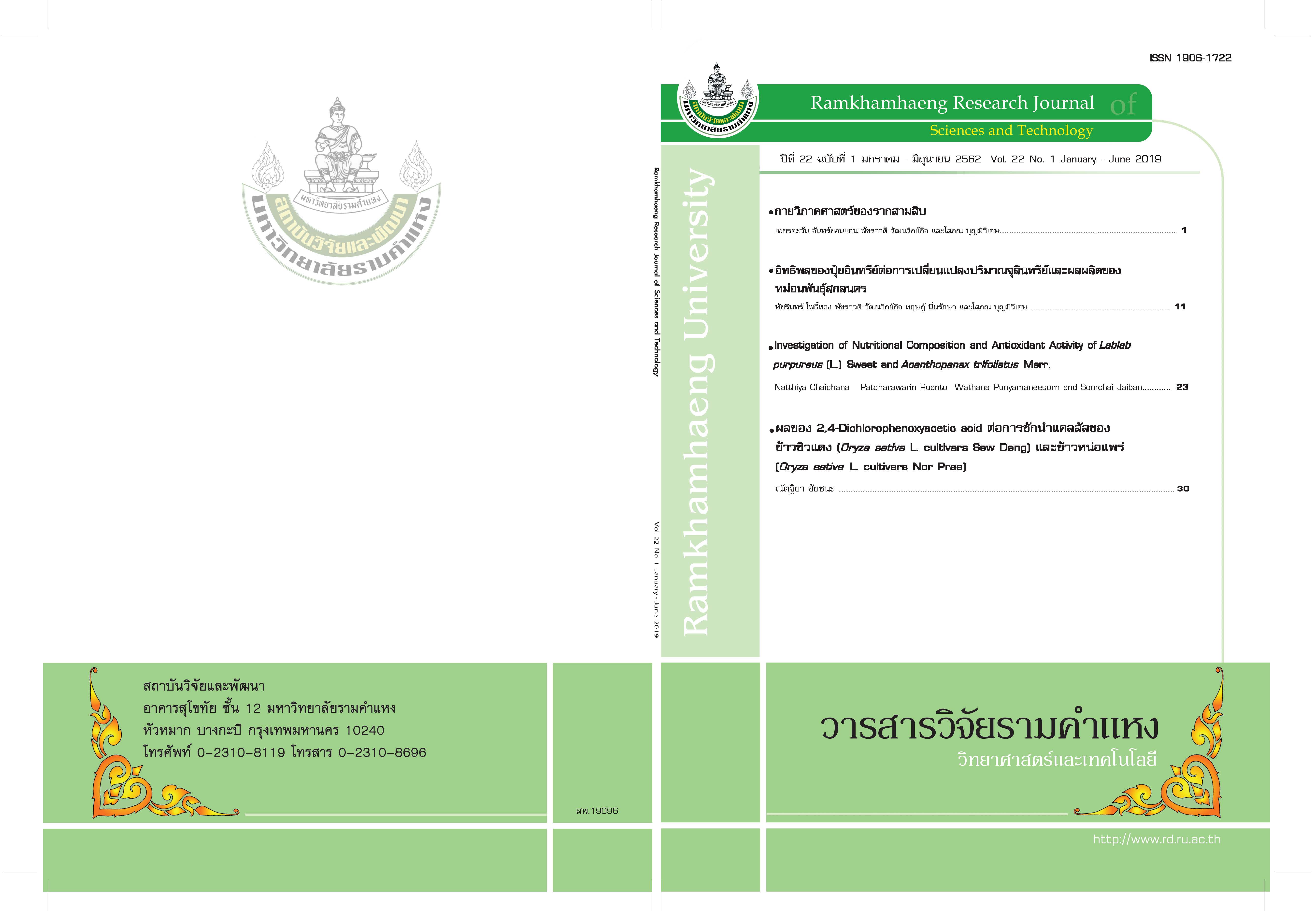Effect of 2,4-Dichlorophenoxyacetic Acid for Callus Induction of Sew Deng Rice (Oryza sativa L. cultivars Sew Deng) and Nor Prae Rice (Oryza sativa L. cultivars Nor Prae)
Main Article Content
Abstract
This research was purposed to investigate the effect of 2,4-dichlorophenoxyacetic acid (2, 4-D) for callus induction of Sew Deng rice (Oryza sativa L. cultivars Sew Deng) and Nor Prae rice (Oryza sativa L. cultivars Nor Prae). The seeds of both cultivars were sterilized by sodium hypochorite (clorox) 15% for 10 minute. Then, embryos were transferred to MS medium supplemented with 2, 4D at four different concentration of 0, 0.5, 1.0 and 2.0 mg/l for 8 weeks. The result revealed that MS medium supplemented with 0.5 mg/l 2,4-D could provide 100% of callus induction of Sew Deng rice and Nor Prae rice with 0.0414 and 0.0652 g dry weight, respectively.
Article Details
How to Cite
ชัยชนะ ณ. (2019). Effect of 2,4-Dichlorophenoxyacetic Acid for Callus Induction of Sew Deng Rice (Oryza sativa L. cultivars Sew Deng) and Nor Prae Rice (Oryza sativa L. cultivars Nor Prae). Ramkhamhaeng Research Journal of Sciences and Technology, 22(1), 30–35. retrieved from https://li01.tci-thaijo.org/index.php/rusci/article/view/217016
Section
Articles
Ramkhamhaeng University
References
กมลทิพย์ สำลีแก้ว, อรพิมล แท่นทอง, ผการัตน์ โรจน์ดวง และ สุภาวดี รามสูตร. 2560. การขยายพันธุ์ข้าวพื้นเมืองพันธุ์กาบดำด้วยเทคนิคการเพาะเลี้ยงเนื้อเยื่อ. วารสารวิชชา. 36(2): 25-35.
จตุพร หงส์ทองคา, อภิญญา สีลาโส, รัชนีกร ทองเฟื่อง และ รชยา พรมวงศ์. 2561. ผลของสารควบคุมการเจริญเติบโตต่อการขยายพันธุ์ข้าวพันธุ์เล้าแตกและข้าวพันธุ์เหนียวแดงในสภาพปลอดเชื้อ. วารสารวิชาการ วิทยาศาสตร์และเทคโนโลยี มหาวิทยาลัยราชภัฎนครสวรรค์. 10(12): 25-34.
ภพเก้า พุทธรักษ์, วารุต อยู่คง, รัฐพร จันทร์เดช, พีระวุฒิ วงศ์สวัสดิ์ และ มณฑล สงวนเสริมศรี. 2556. การชักนำแคลลัสจากการเพาะเลี้ยงเมล็ดของข้าวหอมมะลิ 105 และข้าวเหนียว กข 6. Naresuan Phayao Journal. 6(2): 100-105.
Chunbo, M., Zhigang, W. and Bingyao, S. 2009. Effects of 2, 4-D and 6-BA on callus induction and plantlet regeneration from mature embryos of hsien rice. Hu'nan Agricultural Science & Technology Newsletter. 10(4): 22-26.
Ilahi, I., Bano, S., Jabeen, M. and Rahim, F. 2005. Micropropagation of rice (Oryza sativa L. cv SWAT-II) through somatic embryogenesis. Pakistan Journal of Botany. 37(2): 237-242.
Kadhimi, A.A., Alhasnawi, A.N., Isahak, A., Ashraf, M.F., Mohamad, A., Doni, F., Yusoff, W.M.W. and Mohd Zain, C.R.C. 2014. Effect of genotype and growth regulators in induction of embryogenic callus in rice. Journal of Pure and Applied Microbiology. 8(6): 1-6.
Karthikeyan, A., Pandian, S. T. K. and M. Ramesh. 2009. High frequency plant regeneration from embryogenic callus of a popular indica rice (Oryza sativa L.) Physiology and Molecular Biology of Plants.15(4): 371-375.
Puhan, P. and Siddiq, E.A. 2013. Protocol optimization and evaluation of rice varieties response to in vitro regeneration. Advances in Bioscience and Biotechnology. 4: 647-653.
Revathi, S. and Arumugam Pillai, M. 2011. In vitro callus induction in rice (Oryza sativa L.). Research in Plant Biology. 1(5): 13-15.
Shansavari, E. 2010. Evaluation and Optimizations of Media on the Tissue Culture System of Upland Rice. International Journal of Agriculture and Biology. 12: 537–540.
Wani, S.H., Sanghera, G.S. and Gosal, S.S. 2011. An efficient and reproducible method for regeneration of whole plants from mature seeds of a high yielding Indica rice (Oryza sativa L.) variety PAU 201. New Biotechnology. 28(4): 418–422.
Yan, L.N., Li, X. and Wu, D. 2010. The comparison in tissue culture ability of mature embryo in different cultivars of rice. Agricultural Sciences in China. 9(6): 840–846
จตุพร หงส์ทองคา, อภิญญา สีลาโส, รัชนีกร ทองเฟื่อง และ รชยา พรมวงศ์. 2561. ผลของสารควบคุมการเจริญเติบโตต่อการขยายพันธุ์ข้าวพันธุ์เล้าแตกและข้าวพันธุ์เหนียวแดงในสภาพปลอดเชื้อ. วารสารวิชาการ วิทยาศาสตร์และเทคโนโลยี มหาวิทยาลัยราชภัฎนครสวรรค์. 10(12): 25-34.
ภพเก้า พุทธรักษ์, วารุต อยู่คง, รัฐพร จันทร์เดช, พีระวุฒิ วงศ์สวัสดิ์ และ มณฑล สงวนเสริมศรี. 2556. การชักนำแคลลัสจากการเพาะเลี้ยงเมล็ดของข้าวหอมมะลิ 105 และข้าวเหนียว กข 6. Naresuan Phayao Journal. 6(2): 100-105.
Chunbo, M., Zhigang, W. and Bingyao, S. 2009. Effects of 2, 4-D and 6-BA on callus induction and plantlet regeneration from mature embryos of hsien rice. Hu'nan Agricultural Science & Technology Newsletter. 10(4): 22-26.
Ilahi, I., Bano, S., Jabeen, M. and Rahim, F. 2005. Micropropagation of rice (Oryza sativa L. cv SWAT-II) through somatic embryogenesis. Pakistan Journal of Botany. 37(2): 237-242.
Kadhimi, A.A., Alhasnawi, A.N., Isahak, A., Ashraf, M.F., Mohamad, A., Doni, F., Yusoff, W.M.W. and Mohd Zain, C.R.C. 2014. Effect of genotype and growth regulators in induction of embryogenic callus in rice. Journal of Pure and Applied Microbiology. 8(6): 1-6.
Karthikeyan, A., Pandian, S. T. K. and M. Ramesh. 2009. High frequency plant regeneration from embryogenic callus of a popular indica rice (Oryza sativa L.) Physiology and Molecular Biology of Plants.15(4): 371-375.
Puhan, P. and Siddiq, E.A. 2013. Protocol optimization and evaluation of rice varieties response to in vitro regeneration. Advances in Bioscience and Biotechnology. 4: 647-653.
Revathi, S. and Arumugam Pillai, M. 2011. In vitro callus induction in rice (Oryza sativa L.). Research in Plant Biology. 1(5): 13-15.
Shansavari, E. 2010. Evaluation and Optimizations of Media on the Tissue Culture System of Upland Rice. International Journal of Agriculture and Biology. 12: 537–540.
Wani, S.H., Sanghera, G.S. and Gosal, S.S. 2011. An efficient and reproducible method for regeneration of whole plants from mature seeds of a high yielding Indica rice (Oryza sativa L.) variety PAU 201. New Biotechnology. 28(4): 418–422.
Yan, L.N., Li, X. and Wu, D. 2010. The comparison in tissue culture ability of mature embryo in different cultivars of rice. Agricultural Sciences in China. 9(6): 840–846


